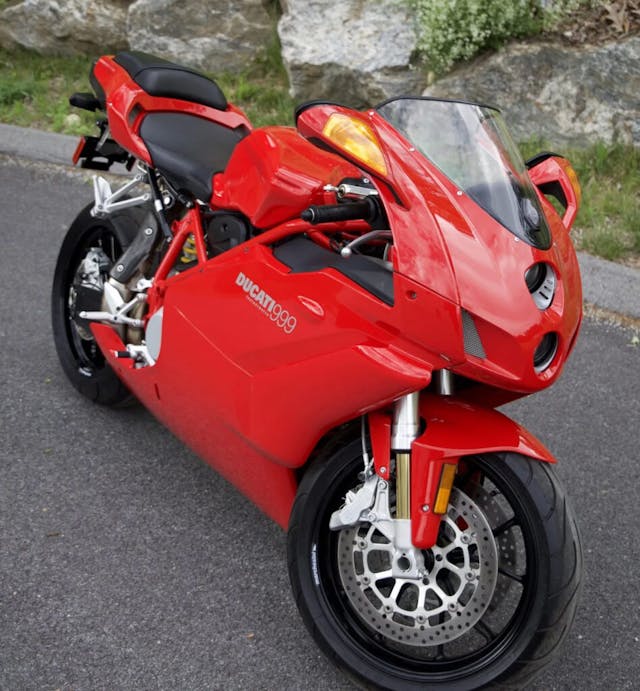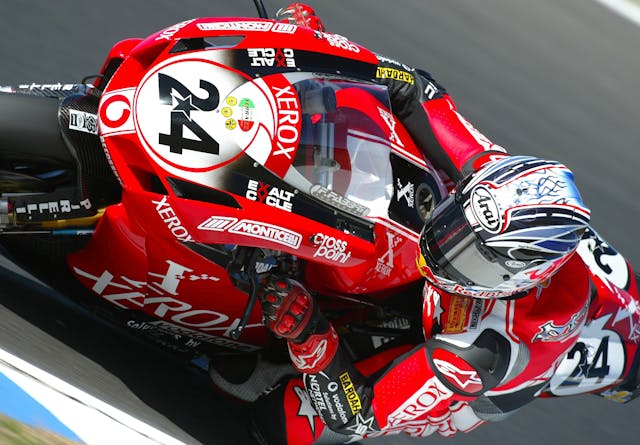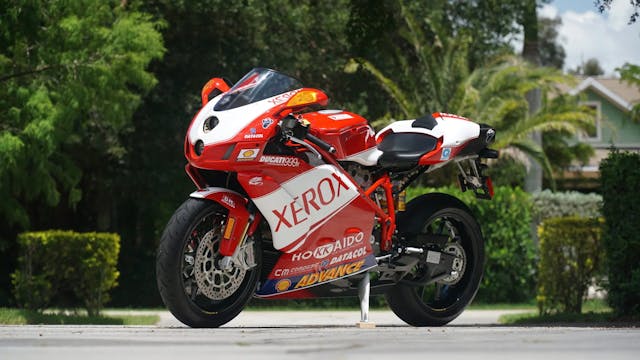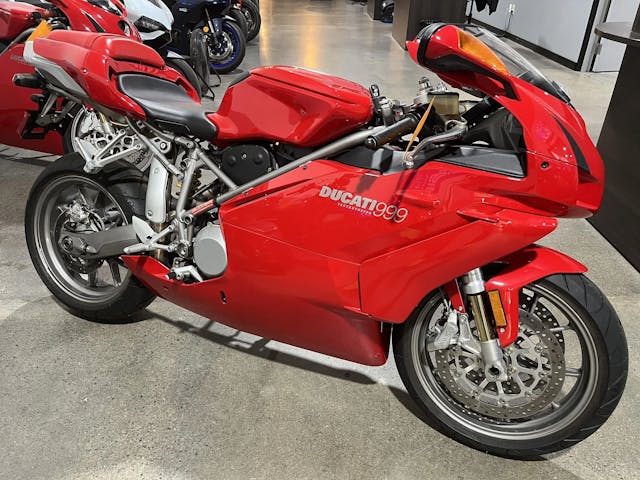Ducati’s 999 is a passionate entry into Italian superbikes
The Ducati 999 is nothing if not controversial. The headlights on this piece of Italian exotica cause some to think more of a freight train than a lusty sport bike. It emits the seemingly standard, concerning engine rattles. It manages to be slower than a contemporary Japanese bike that costs 40 percent less. Yet the 999 is a piece of art that ignites passion from fans across the world. I know this firsthand: I took my motorcycle test at age 16 on my dad’s 999, and I have counted myself as one of the bike’s fans ever since.
Beginning with the 916 in 1994 and running through the 996 and 998, Ducati had a run of similarly designed bikes widely considered among the prettiest modern motorcycles made. When it came time to put pen to paper for the 999, Ducati designers decided to do something radically different. Surely a fresh take would be a hit and move the brand forward, right?

It didn’t unfold that way. The 999 was released in 2003 to mixed reviews thanks to its radical styling. The sleek 998 gave way to the 999’s stacked headlights and aero that was more purposeful than pretty. It was built to bring Ducati into the modern era of superbike racing, and fast doesn’t always mean beautiful. Still, the 999 remained quintessentially Ducati—a bike that makes you feel as if you’re a millionaire with only $20K in the bank.
Superbike DNA coursed through every part of the 999. The riding experience was everything but comfortable. There was no point in keeping it cool at slow speeds because it would only be going fast on a track. You don’t need mirrors you can actually use, because aero for track. Nothing but full tuck because, well, track. This made the 999 an animal on the street, but that was all okay because, well, Ducati. See the theme?

I have ridden a Ducati 999 on and off for the last 13 years. My dad bought his new in 2005 and for some unknown reason he handed me the keys at 16 to take my license test on and ride to high school. How am I alive? I ask myself that every day. As a younger rider I can put up with a stretched, uncomfortable position, but having ridden 100 or more motorcycles, I can say the 999 is the only model on which I never feel fully relaxed unless I’m on a straight road at 45 mph with nothing around.
What’s it like to live with? First, the experience around town. It’s not great.
This bike does not do well in stop-and-go traffic no matter what. Your butt and legs will get very hot from the underseat exhaust and poor heat management. Aftermarket exhausts or extra heat shields can alleviate this somewhat. The dry clutch is a signature feature of Ducati bikes, but that doesn’t mean it’s a good thing. The rattle at idle with the clutch pulled in will have you wondering if your bike is broken, and managing the clutch is a bit difficult if you’re cruising town. The clutch is very stiff; I often find myself flexing my fingers to get rid of cramps. Smooth engagement is tough if you don’t rev the bike enough—you need to approach “Ducati bro revving engine at stoplight” levels if you don’t want an unexpected stall. When that clutch does heat up it will very happily groan and squeal if you run it in the friction zone too long. Those mirrors? You’re probably safer turning around backwards for ten seconds.
In retrospect, maybe my dad figured that, if I could ride a 999, I’d be prepared to handle anything. But there’s another side to this bike that he knew about and no doubt wanted to share.
The 999 sings on the open road. The track-oriented DNA that is a liability in stop-and-go riding transforms into an asset on windy roads and makes it one of the most euphoric sportbikes of its era. When you’re tucked behind the screen with your weight on your wrists and two fingers on the clutch, and start to roll into the throttle, you can’t help but grin ear-to-ear. The high-revving V-twin’s harmonics make the bike feel alive, and its roar is something between the deep wallop of a V-8 and the eager zing of an inline four. It’s even more pronounced with the Termignoni exhaust that came on the 999S and 999R models.
The 999 is the pinnacle of a love/hate motorcycle duality. Visually and experientially, it’s captivatingly beautiful and ugly at the same time. It’s shockingly fast but slower than a Suzuki GSX-R from the same year. It’s uncomfortable to ride but you’ll ever want to get rid of it.
What does it take to buy a 999 today? There are three models with very different values: the 999 Base, 999S, and 999R. Of the base models, the ones you want are the 2005 and 2006 model years. They got 18 more horsepower—a significant boost for a motorcycle—and the black frame and wheel combination is preferred over the earlier silver. Values are still shockingly low for these, though their depreciation has bottomed. You can get one with roughly 5000 miles for $6500 to $8000, up from $5500 to $6500 only a couple years ago.

The 999S adds suspension improvements and subtracts some weight while bumping prices up 65 to 75 percent to $11,000–$15,000 for very good examples. On top of the improvements to the S, the 999R features carbon bodywork and extensive strengthening of the engine internals for more power. Good-condition 999Rs can be had for around $16,500, and $27,000 will get you the best of the best. They clearly haven’t hit the collector realm yet, as witnessed by a 22-mile base bike selling for only slightly more than $10,000. That said, the market tends to recognize characterful bikes, even if it takes a while. The whole model range has potential, but with the personality and the racing-livery looks to match, the 999R Fila and Xerox models are primed for serious collectible status.

It’s important to go into any purchase with eyes wide open—any 999 is a raw piece of machinery that refuses to coddle you. Remember, a Ducati is a Ducati. That lump of aluminum between your legs will overcome any mixed feelings about freight train headlights, or a stat sheet that isn’t as strong as a cheaper Japanese bike. If you want a passionate riding experience you won’t forget, it’s hard to go wrong with the 999.
***
Check out the Hagerty Media homepage so you don’t miss a single story, or better yet, bookmark it. To get our best stories delivered right to your inbox, subscribe to our newsletters.



James, your dad either had a lot of confidence in not only your riding, but your restraint. Either that, or you ate a ton as a teenager, and he was hoping to cut that food bill way down! 💀
I’ve wanted a Ducati in my garage for a long time. They keep getting better. I would probably be wiser to choose the smaller, step-down size to limit the amount of horsepower with which I can get into trouble. 😁
Great article James. But “The rattle at idle with the clutch pulled in”, was the opposite i.e. “Before the clutch is pulled in”
Wrong!
I owned a 999s w Termis. This is bike is not an “entry” to Italian bikes. The typical cost of service (every 6k miles) is close to 1/4 the value of the bike. This is a 2nd or 3rd bike. Aprilia on the other hand is very I inexpensive to buy and service. Even MV Augusta is less expensive to maintain.
Having said that I do like that this design is finally recognized, the power plant is a joy and the stability of the chassis is great.
Just not a great 1st Italian bike, maintenance will ruin that experience.
I’ve had three 999s. The last a Parts Unlimited 999s signed by the racers. No sport bike is comfortable but the 999 is much more comfortable than any Japanese bike of the time for taller riders in my opinion. As far as clutch issues, the bike was geared way too high for street use. Putting on a taller front sprocket brought the incredibly torquey bike even more torque and made take offs a breeze. 90+ mph in first gear may work on a track but in normal riding it doesn’t make a whole lot of sense. I’ve had an 1198 as well and it just isn’t as fun a bike. The 999 was fast and quick without being scary or peaky. And the sound was incredible. All Ducatis sound good but my 999 with an oddball but excellent Akropovic pipe sounded heavenly. I highly recommend them to anyone
I like the looks though I still prefer the Japanese bikes myself.
*Shorter front sprocket my mistake
Just reading this story got me excited for my next ride Lola (too pretty to be brutish, too brutish to be pretty).
Agree with everything said. Have owned many bikes, including the Gixxer, but none have made me smile more when I open the garage door or sound more thrilling including the ‘bag or spanners’ dry clutch. I learned to do cam belts and valve clearances myself. This is a racing bike meant to be assembled and disassembled many times in its lifetime unlike other brands I have owned. Even when I stop riding, this will remain in my hands. If only I could hang it on the wall.
My thoughts exactly. I remember the guys at the local Ducati shop wearing “loud clutches save lives!” T shirts in a healthy ribbing of the Harley set!
But will Hagerty insure a 999? They wouldn’t insure my 748S, which I bought and tried to get a quote on not long after their 916 article was posted here a couple years ago.